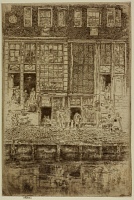The Embroidered Curtain | ||
| Number: | 451 | |
| Date: | 1889 | |
| Medium: | etching and drypoint | |
| Size: | 239 x 161 mm | |
| Signed: | butterfly at upper left | |
| Inscribed: | no | |
| Set/Publication: | no | |
| No. of States: | 10 | |
| Known impressions: | 27 | |
| Catalogues: | K.410; M.411 | |
| Impressions taken from this plate (27) | ||
TECHNIQUE
This elaborate composition was mostly etched, with some additions in drypoint, as the composition was developed through ten states. Whistler made extensive alterations to The Embroidered Curtain, Amsterdam, which required the plate to be reheated, laid on an anvil, and hammered with the ball of a hammer over unsatisfactory areas. Burnished, recoated, etched and rebitten, the plate was then reprinted. This is seen in the late states, where the reflections, slightly over-bitten in earlier states, were removed, and replaced with 'scattered, scratchy lines ... barely disguised in some impressions by printing the plate with additional tone in the water.' 17 The size of the edition may have been limited by the complexity of the lightly etched linework, which did not stand up very well to the printing press. 18
17: Heijbroek 1997[more], p. 79.
18: ibid, p. 81.
PRINTING
Some proofs were not working proofs in the sense of rough pulls kept by the artist, but carefully printed, fully worked out impressions, that were marked, for instance 'Trial proof' by the artist ().
According to Mansfield, there were impressions of the first state in the Lathrop and Simpson Collections: 'On the impression in the Simpson Collection Whistler wrote: "1st proof pulled," and on the impression in the Lathrop Collection: "2nd proof pulled."' 19 This is not entirely accurate; one impression is inscribed '1st proof printed' () but none - and certainly not the impression owned by Bryan Lathrop (1844-1916), although it is an impression of the first state () - now bears the inscription '2nd proof pulled'.
19: Mansfield 1909[more] (cat. no. 411).
Whistler was slow in completing and printing the plate. Howard Mansfield (1849-1938) apparently saw proofs of The Embroidered Curtain, Amsterdam about March 1890, but complained on 15 May that he had not received any impressions. 20
20: GUW #03989.
Regarding the number of impressions pulled from his copper plates, Whistler said that 'the numbers vary according to his judgement. Sometimes there might be a hundred, but oftimes a dozen or twenty proofs, each having the sign of the butterfly, and the little note which shows that he also printed the proof.' 21 His studio, wrote a journalist, was 'like a workshop' full of 'the presses and inking trolleys with which he is now at work'. 22
He may have aimed, in this case, at a print-run of two dozen or even thirty impressions. In one studio stock-taking twenty-two impressions were recorded. 23 He printed a further two impressions on 13 August 1890. 24
Sometimes Whistler used old Dutch paper for printing the Amsterdam etchings, which seems particularly appropriate. A late impression of The Embroidered Curtain, Amsterdam, for instance, is on 'Arms of Amsterdam' watermarked paper ().
He may have aimed, in this case, at a print-run of two dozen or even thirty impressions. In one studio stock-taking twenty-two impressions were recorded. 23 He printed a further two impressions on 13 August 1890. 24
Sometimes Whistler used old Dutch paper for printing the Amsterdam etchings, which seems particularly appropriate. A late impression of The Embroidered Curtain, Amsterdam, for instance, is on 'Arms of Amsterdam' watermarked paper ().
21: 'A Chat With Mr Whistler', Pall Mall Budget, 13 March 1890 (GUL PC11/21).
22: Ibid.
23: [1890/1891], GUW #13236.
24: Heijbroek 1997[more], p. 91.
The first state, printed in dark brown ink on ivory Japanese paper () and cream 'antique' (pre-1800) laid () was followed by impressions in brown ink on ivory laid (), dark brown ink on cream tissue, probably Asian () and black ink on ivory Japanese (). A fourth state is in dark brown ink on ivory coated laid paper () and fifth states in brown on ivory laid (, )
Most impressions of the next five states are in dark brown ink on laid papers, including thin ivory 'antique' laid (, ); buff () and ivory laid (); cream 'antique' (); and ivory laid paper with a post horn watermark (). One is in brown ink on ivory wove paper (), and a few are in black ink including one on light-weight off-white laid paper ().
The final - tenth - state is mostly in dark brown ink on laid paper, ivory (, ); ivory with the Arms of Amsterdam watermark (); light-weight off-white (); ivory 'modern' (post-1800) (); cream 'antique' laid (); as well as an ivory laid paper, possibly Asian ().
